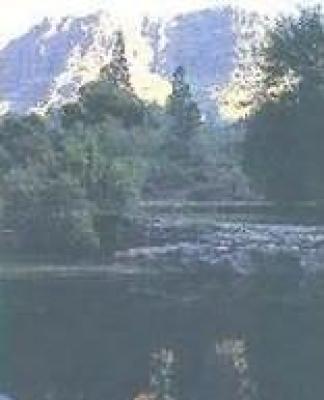One of Southern Africa's richest and most beautiful natural kingdoms is that of the Westem Cape mountains, a majestic and irregular sweep of peak and precipice stretching northwards from the Cedarberg, then south to the Cape Peninsula (and Table Mountain) and up to Port Elizabeth and the Eastem Cape.
The mountains are supreme recreational areas, and most are accessible by extensive but discreet footpaths. They are a paradise for rock-climbers and backpackers - the astounding combination of magnificent peaks, cool sparkling streams in well-wooded valleys and the floristic wealth is unsurpassed on earth. This is the home of the 'Cape Floral Kingdom' or Fynbos Biome.
The world is divided by botanists into six botanical kingdoms, of which the Cape is one. Although it covers only 0, 04 per cent of the area of the earth (compared to the Palaeotropic Kingdom, which encompasses 35 per cent and includes the rest of Africa south of the Sahara), this floral kingdom, in botanical terms, is the richest area on the planet.
More than 8 500 plant species are found in the fynbos, of which 6 000 are endemic to specific areas. In a relatively small area of 10 000 ha in the Hottentots-Holland Mountains you may find as many as 121 different species.
Fynbos in its typical form has three distinctive elements - the proteoids proteas, pincushions, mimetes and similar plants, ericoids (heaths and false heather), and restioids (reedlike sedges with beautiful brown flower heads).
Many of our familiar garden plants, such as Sparaxis, Jxia, Agapantus, Watsonia, blushing bride, heather, red-hot poker and others, grow naturally in the Western Cape mountains. Outcrops of fynbos species are found as far north as Nieuwoudtville and become more common as you move south.
To the south of the Cederberg lie the Koue-Bokkeveld berge - mostly privately owned, though several thousand hectares have been declared a mountain catchment area. The Citrusdal protea (Protea rnopina) and the Bokkeveld ground protea (Protea scabriuscula) occur here. Immediately southwest of this area are the Groot Winterhoek Mountains, where a large wildemess area has been proclaimed.
South of the town of Tulbagh, the Elandskloof, Limietberg and Slanghoek ranges reach towards Wellington, where they become the Hawekwas Mountains. This is the home of three lovely proteas: the Mountain Rose, a small protea with drooping flower heads; the very rare Kasteelskloof protea and the Krantz protea.
The historic Bainskloof Pass separates this range from the Du Toitskloof range, which stretches out towards Worcester and becomes Klein Drakenstein, Wemmershoek, Stettyns and eventually Hex River as it reaches De Doorns.
Heaths, sedges, disas and many other flowers grow here in profusion. The mountains of Drakenstein, Paarl, Franschhoek, Jonkershoek, Simonsberg and Stellenbosch are equally beautiful. In these valleys are the wine routes and stately Cape Dutch homes. Further south, the Hottentots-Holland range reaches towards Sir Lowry's Pass, on the other side of which is the Kogelberg.
This is the richest of all the Cape mountains in terms of flora, with its very rare Marsh Rose, Silver mimetes, Stokoe's protea and many other endemic species. From Betty's Bay to Bot River, the Palmiet Mountains tower above the sea. Various trails can be followed here in the forests, home of a famous export protea - the Bot River protea (Protea cornpacta).
The most famous of all South African mountains is Table Mountain, with its attendants, Lion's Head, Devil's Peak, Twelve Apostles and Constantiaberg. This area offers a host of rewarding walks and climbs that vary in gradient and challenge to suit hikers of all fitness levels.
The Riviersonderend range between Genadendal and the town of Riviersonderend (Boosmansbos) also offers a variety of tracks and footpaths (maintained by the local nature conservator).
The Langeberg range extends from Worcester eastwards towards the Gourits River - the Little Karoo lies at its northern slopes and the Overberg to the south, presenting hikers with an ever-changing vista of farmlands. Historic towns and villages such as Swellendam, Montagu, Barrydale, Riversdale and Albertinia nestle at its feet.
Further north rise the austere cliffs of the Anysberg (Aniseed Mountain), Towerkop (Magic Peak) and Swartberg - home of the Towerkop snow protea (Protea prurnosa). The nature conservator in this area controls large tracts of state land and privately owned catchment areas.
It is a place of rare beauty - Gamkaskloof ('The Hell'), Seweweekspoort, Swartberg Pass, Meiringspoort and Huisrivier Pass are all well-known landmarks. Even drier and more rugged, but equally beautiful are the Baviaanskloof, Kouga and Cockscorn mountains.
This is a vast, undulating expanse of land, with breathtaking valleys, rugged peaks and countless twisting footpaths. To the south is the Langkloof range. The southern valley wall is formed by the lush evergreen peaks of the Outeniqua and Tsitsikamma mountains - thousands of hectares of land protected by foresters.
George Peak and Formosa Peak are well-known landmarks, as are the historic Montagu Pass, Prince Alfred's Pass, Bloukrans, Gamka and Grootrivier. The forests on the southern slopes are famous for their yellowwood and stinkwood.
Most Westem Cape (and Garden Route) mountains are managed as nature reserves, wilderness areas or mountain catchment areas by the provincial government.






